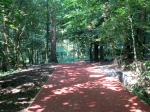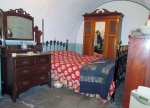 I decide to get up earlier then I had planned as I just cannot seem to get back to sleep after getting woken by the rumbling of a truck on the street outside. Oh well, Bernard’s dad left early this morning for a cruise so I have the place to myself for the rest of my visit. Pip has invited me up to their house for a traditional Welsh breakfast so after spending a little time on the internet, taking a shower, I begin the mile and a half walk to their place. When I arrive she is finishing up and soon breakfast is served. Eggs, toast, sausage are all pretty regular breakfast fare for me, but then she threw in baked beans and blood sausage. Pip chuckles
I decide to get up earlier then I had planned as I just cannot seem to get back to sleep after getting woken by the rumbling of a truck on the street outside. Oh well, Bernard’s dad left early this morning for a cruise so I have the place to myself for the rest of my visit. Pip has invited me up to their house for a traditional Welsh breakfast so after spending a little time on the internet, taking a shower, I begin the mile and a half walk to their place. When I arrive she is finishing up and soon breakfast is served. Eggs, toast, sausage are all pretty regular breakfast fare for me, but then she threw in baked beans and blood sausage. Pip chuckles  when I turn down the coffee and requests a diet coke. Her food is spot on but after a taste of the baked beans and blood sausage I realize I am not a fan of these two foods this early in the morning. Okay, maybe I don’t care for blood sausage at all. After we eat and clean up, we head out the front door to begin our journey. At the end of their street we come to a red pebble path which leads us into a lush wooded area. The path takes us up and down hills through the large grove. After about forty five minutes we
when I turn down the coffee and requests a diet coke. Her food is spot on but after a taste of the baked beans and blood sausage I realize I am not a fan of these two foods this early in the morning. Okay, maybe I don’t care for blood sausage at all. After we eat and clean up, we head out the front door to begin our journey. At the end of their street we come to a red pebble path which leads us into a lush wooded area. The path takes us up and down hills through the large grove. After about forty five minutes we  the narrow stairs we come to a room filled with a wonderful collection of artifacts from the iron age. A great tribute to the time when the wealth of this region created this masterpiece. Memorabilia from the homes, mines, and living quarters of the workers fill the rooms on the lower level. A small area is dedicated to the Merthyr Tydfil rising of 1831. This uprising by the workers was in response to the rise in costs and decrease in quality of products available for purchase. During this period the iron workers were paid in notes known as “truck”. The truck notes could only be used at stores owned by the companies they worked for, so the iron workers had little freedom to find better pricing or quality. 7,000-10,000 workers marched and kept iron-masters under siege for four days. Soldiers were called in and several demonstrators and military where killed. This uprising helped create momentum for the movement which later lead to the Reform act of 1852. I enjoy our time learning about the history, but soon it is time to head upstairs to see what awaits us there. Rooms lit with phenomenal chandeliers, original wallpaper and drapes are filled with Egyptian artifacts once collected by William Crawshay. All in excellent condition and telling the story of his families life. It is simply a wonderful collection and I would encourage anyone to explore it for themselves, but soon it is time to move on.
the narrow stairs we come to a room filled with a wonderful collection of artifacts from the iron age. A great tribute to the time when the wealth of this region created this masterpiece. Memorabilia from the homes, mines, and living quarters of the workers fill the rooms on the lower level. A small area is dedicated to the Merthyr Tydfil rising of 1831. This uprising by the workers was in response to the rise in costs and decrease in quality of products available for purchase. During this period the iron workers were paid in notes known as “truck”. The truck notes could only be used at stores owned by the companies they worked for, so the iron workers had little freedom to find better pricing or quality. 7,000-10,000 workers marched and kept iron-masters under siege for four days. Soldiers were called in and several demonstrators and military where killed. This uprising helped create momentum for the movement which later lead to the Reform act of 1852. I enjoy our time learning about the history, but soon it is time to head upstairs to see what awaits us there. Rooms lit with phenomenal chandeliers, original wallpaper and drapes are filled with Egyptian artifacts once collected by William Crawshay. All in excellent condition and telling the story of his families life. It is simply a wonderful collection and I would encourage anyone to explore it for themselves, but soon it is time to move on.
We head back out the front passage into the well manicured gardens which surround the mansion. A wonderful fountain with its decorative angels adorning the edges of the  surrounding pool and its statuary children placed on the top of the column in the middle trickles water as we stop to take a rest before we continue our journey. We head towards the exit and as we leave the property we admire the entrance with it iron gate and the clock which was placed on the tower across the street. This clock was installed by William so he could see if the mines should be operational or closed for the day.
surrounding pool and its statuary children placed on the top of the column in the middle trickles water as we stop to take a rest before we continue our journey. We head towards the exit and as we leave the property we admire the entrance with it iron gate and the clock which was placed on the tower across the street. This clock was installed by William so he could see if the mines should be operational or closed for the day.
 We continue our journey through the village exploring many of its nooks and crannies. It is a wonderful morning and afternoon and our journey takes us past a beautiful little church. We approach front door to peak through window to see if we can see the sanctuary. Inside the church we see two lady’s preparing the sanctuary for the next weeks activities. One of the ladies notice us and soon we are inside looking around. Enjoying the wonderful architecture of the sanctuary. Exploring all aspects from the old retired organ on the back balcony to the detailed ivory alter in the front. All while the lady’s share the stories and history of the church mixed with the stories of their lives. It is a wonderful part of our journey but soon the end comes and we head back up the hill to Pip’s house. We have walked miles as it is now late afternoon and we are hungry so to complete our day, Pip and her family invite me for dinner at one of their favorite local Welsh establishments. What a great exclamation point to a great day.
We continue our journey through the village exploring many of its nooks and crannies. It is a wonderful morning and afternoon and our journey takes us past a beautiful little church. We approach front door to peak through window to see if we can see the sanctuary. Inside the church we see two lady’s preparing the sanctuary for the next weeks activities. One of the ladies notice us and soon we are inside looking around. Enjoying the wonderful architecture of the sanctuary. Exploring all aspects from the old retired organ on the back balcony to the detailed ivory alter in the front. All while the lady’s share the stories and history of the church mixed with the stories of their lives. It is a wonderful part of our journey but soon the end comes and we head back up the hill to Pip’s house. We have walked miles as it is now late afternoon and we are hungry so to complete our day, Pip and her family invite me for dinner at one of their favorite local Welsh establishments. What a great exclamation point to a great day.